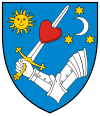|
Zăbala
Zăbala (Hungarian: Zabola, pronounced [ˈzɒbolɒ]; German: Gebissdorf) is a commune in Covasna County, Romania. It lies in the Székely Land, an ethno-cultural region in eastern Transylvania. The commune comprises 4 villages: Peteni (Székelypetőfalva), Surcea (Szörcse), Tamașfalău (Székelytamásfalva), and Zăbala. GeographyThe commune is located in the eastern part of the county, on the border with Vrancea County. It lies on the banks of Râul Negru and its tributaries, the rivers Zăbala and Mărcușa. Zăbala is crossed by county road DJ121, which connects it to Covasna, 6 km (3.7 mi) to the south, and Târgu Secuiesc, 14.5 km (9 mi) to the north. The county seat, Sfântu Gheorghe, is 39 km (24 mi) to the west. Demographics
The commune has a Székely Hungarian majority. At the 2002 census, it had a population of 4,814, of which 76.55% were Hungarians and 18.82% Romanians. At the 2011 census, there were 4,597 inhabitants; of those, 68.87% were Hungarians, 19.27% Romanians, and 9.03% Roma. At the 2021 census, Zăbala had a population of 4,332, of which 63.67% were Hungarians, 18.37% Romanians, and 11.45% Roma.[3] Name  The name of "Zabola" means "bridle", i.e., the straps of leather that are put around the head of a horse to allow the rider to control it. In the course of various battles with the Tatars, the villages north and south of Zabola were destroyed by the Tatars. However, the inhabitants of Zabola were capable of holding the Tatars in check and survived, as if they had put bridles around the Tatars' horses in order to control them and their riders. Outside the village lies the "Tatárhalom" (Tatar Hill); some historians think the Tatars that were killed in action were buried there. HistoryThe locality formed part of the Székely Land region of the historical Transylvania province. From 1876 until 1918, the village belonged to the Háromszék County of the Kingdom of Hungary. In the aftermath of World War I, the Union of Transylvania with Romania was declared in December 1918. At the start of the Hungarian–Romanian War of 1918–1919, the town passed under Romanian administration. After the Treaty of Trianon of 1920, it became part of the Kingdom of Romania and fell within plasa Covasna of Trei Scaune County. In 1940, the Second Vienna Award granted Northern Transylvania to the Kingdom of Hungary. In September 1944, during World War II, Romanian and Soviet armies entered the locality. The territory of Northern Transylvania remained under Soviet military administration until March 9, 1945, after which it became again part of Romania. Between 1952 and 1960, Zăbala belonged to the Magyar Autonomous Region, and between 1960 and 1968 it was part of the Brașov Region. In 1968, when Romania was reorganized based on counties rather than regions, the commune became part of Covasna County. Notable people
Things to see
References
|
|||||||||||||||||||||||||||||||||||||||||||||||||||||||||||||||||||




